Page 438 of 509
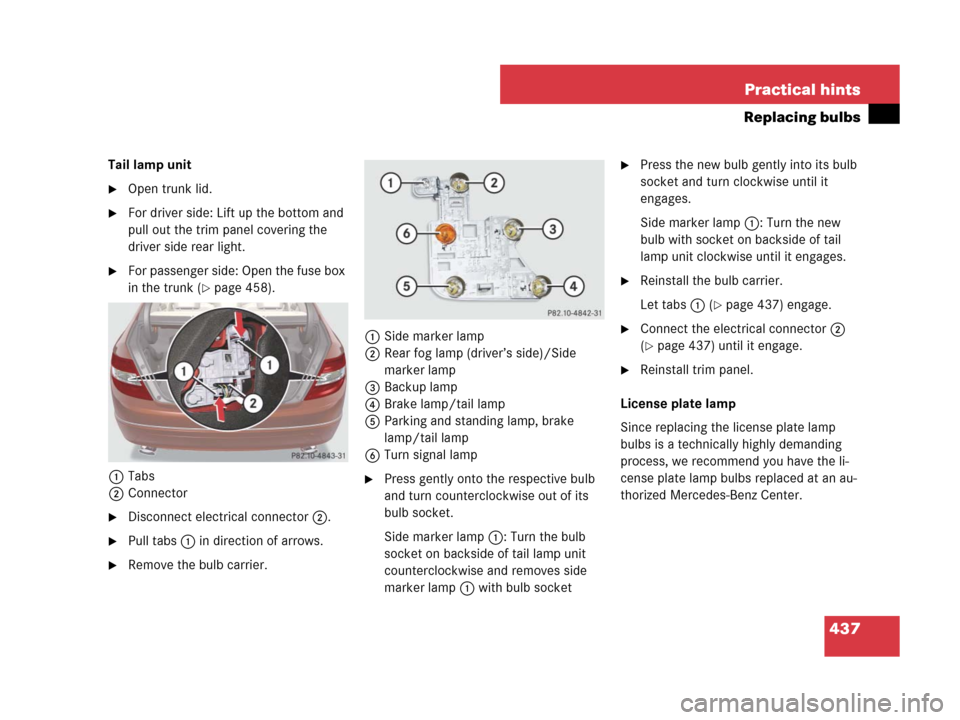
437 Practical hints
Replacing bulbs
Tail lamp unit
�Open trunk lid.
�For driver side: Lift up the bottom and
pull out the trim panel covering the
driver side rear light.
�For passenger side: Open the fuse box
in the trunk (
�page 458).
1Tabs
2Connector
�Disconnect electrical connector2.
�Pull tabs1 in direction of arrows.
�Remove the bulb carrier.1Side marker lamp
2Rear fog lamp (driver’s side)/Side
marker lamp
3Backup lamp
4Brake lamp/tail lamp
5Parking and standing lamp, brake
lamp/tail lamp
6Turn signal lamp
�Press gently onto the respective bulb
and turn counterclockwise out of its
bulb socket.
Side marker lamp1: Turn the bulb
socket on backside of tail lamp unit
counterclockwise and removes side
marker lamp1 with bulb socket
�Press the new bulb gently into its bulb
socket and turn clockwise until it
engages.
Side marker lamp1: Turn the new
bulb with socket on backside of tail
lamp unit clockwise until it engages.
�Reinstall the bulb carrier.
Let tabs1 (
�page 437) engage.
�Connect the electrical connector2
(
�page 437) until it engage.
�Reinstall trim panel.
License plate lamp
Since replacing the license plate lamp
bulbs is a technically highly demanding
process, we recommend you have the li-
cense plate lamp bulbs replaced at an au-
thorized Mercedes-Benz Center.
Page 440 of 509
439 Practical hints
Replacing wiper blades
Removing wiper blades
�Make sure the vehicle’s on-board elec-
tronic have status 0 (
�page 82).
�Fold the wiper arm forward until it
snaps into place.
1Right angle
2Removing
�Turn the wiper blade at a right angle to
wiper arm (arrow 1).
�Slide the wiper blade sideways out of
the retainer in the direction of
arrow2.
Installing wiper blades
�Slide the wiper blade onto wiper arm
until it locks in place.
�Rotate the wiper blade into position
parallel to wiper arm.
�Fold the wiper arm backward to rest on
the windshield. Make sure you hold
onto the wiper when folding the wiper
arm back.
!Do not pull on the wiper blade inserts. They
could tear.
!Make certain that the wiper blades are prop-
erly installed. Improperly installed wiper blades
may cause windshield damage.
Page 442 of 509

441 Practical hints
Flat tire
Mounting the Minispare wheel
Preparing the vehicle
�Prepare the vehicle as described
(
�page 440).
�Take vehicle tool kit tray and vehicle
jack out of trunk (
�page 420).
�Take the Minispare wheel from the
wheel well under the trunk floor
(
�page 422).Lifting the vehicle
Warning!G
When jacking up the vehicle, only use the
jack which has been specifically approved
by Mercedes-Benz for your vehicle.
The jack is designed exclusively for jacking
up the vehicle at the jack take-up brackets
built into both sides of the vehicle. Make
sure the jack arm is fully seated in the jack
take-up bracket.
The jack is intended only for lifting the
vehicle briefly for wheel changes. It is not
suited for performing maintenance work
under the vehicle. To help avoid personal
injury, use the jack only to lift the vehicle
during a wheel change.
Never get beneath the vehicle while it is sup-
ported by the jack. Keep hands and feet
away from the area under the lifted vehicle.
Always lower the vehicle onto sufficient
capacity jackstands before working under
the vehicle.
Always firmly set the parking brake and
block wheels with wheel chocks or other
sizeable objects before raising vehicle with
jack. Do not release the parking brake while
the vehicle is raised.
Make sure that the ground on which the
vehicle is standing and where you place the
jack is solid, level and not slippery. If neces-
sary, use a large underlay. On slippery
surfaces, such as tiled floors, you should
use a non-slip underlay, for example a
rubber mat.
Do not use wooden blocks or similar objects
to support the jack. Otherwise the jack may
not be able to achieve its load-bearing
capacity if it is not at its full height.
Be certain that the jack is always vertical
(plumb line) when in use, especially on hills.
Always try to use the jack on level surface.
Never start the engine when the vehicle is
raised.
Also observe the notes on the jack.
Page 443 of 509
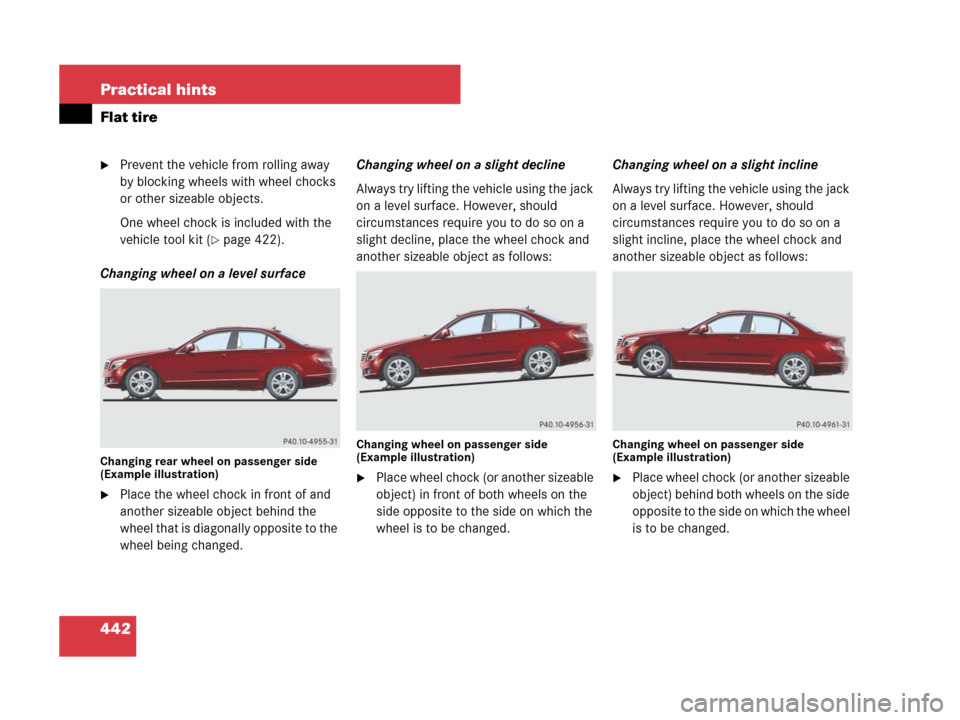
442 Practical hints
Flat tire
�Prevent the vehicle from rolling away
by blocking wheels with wheel chocks
or other sizeable objects.
One wheel chock is included with the
vehicle tool kit (
�page 422).
Changing wheel on a level surface
Changing rear wheel on passenger side
(Example illustration)
�Place the wheel chock in front of and
another sizeable object behind the
wheel that is diagonally opposite to the
wheel being changed.Changing wheel on a slight decline
Always try lifting the vehicle using the jack
on a level surface. However, should
circumstances require you to do so on a
slight decline, place the wheel chock and
another sizeable object as follows:
Changing wheel on passenger side
(Example illustration)
�Place wheel chock (or another sizeable
object) in front of both wheels on the
side opposite to the side on which the
wheel is to be changed.Changing wheel on a slight incline
Always try lifting the vehicle using the jack
on a level surface. However, should
circumstances require you to do so on a
slight incline, place the wheel chock and
another sizeable object as follows:
Changing wheel on passenger side
(Example illustration)
�Place wheel chock (or another sizeable
object) behind both wheels on the side
opposite to the side on which the wheel
is to be changed.
Page 445 of 509
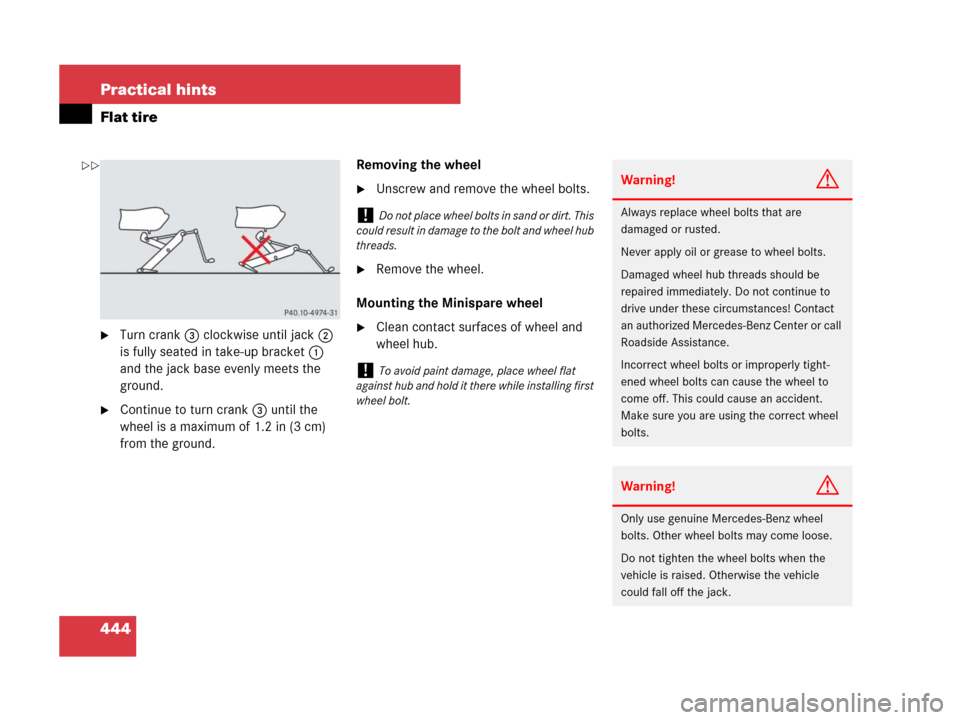
444 Practical hints
Flat tire
�Turn crank3 clockwise until jack 2
is fully seated in take-up bracket1
and the jack base evenly meets the
ground.
�Continue to turn crank 3 until the
wheel is a maximum of 1.2 in (3 cm)
from the ground.Removing the wheel
�Unscrew and remove the wheel bolts.
�Remove the wheel.
Mounting the Minispare wheel
�Clean contact surfaces of wheel and
wheel hub.
!Do not place wheel bolts in sand or dirt. This
could result in damage to the bolt and wheel hub
threads.
!To avoid paint damage, place wheel flat
against hub and hold it there while installing first
wheel bolt.
Warning!G
Always replace wheel bolts that are
damaged or rusted.
Never apply oil or grease to wheel bolts.
Damaged wheel hub threads should be
repaired immediately. Do not continue to
drive under these circumstances! Contact
an authorized Mercedes-Benz Center or call
Roadside Assistance.
Incorrect wheel bolts or improperly tight-
ened wheel bolts can cause the wheel to
come off. This could cause an accident.
Make sure you are using the correct wheel
bolts.
Warning!G
Only use genuine Mercedes-Benz wheel
bolts. Other wheel bolts may come loose.
Do not tighten the wheel bolts when the
vehicle is raised. Otherwise the vehicle
could fall off the jack.
��
Page 446 of 509
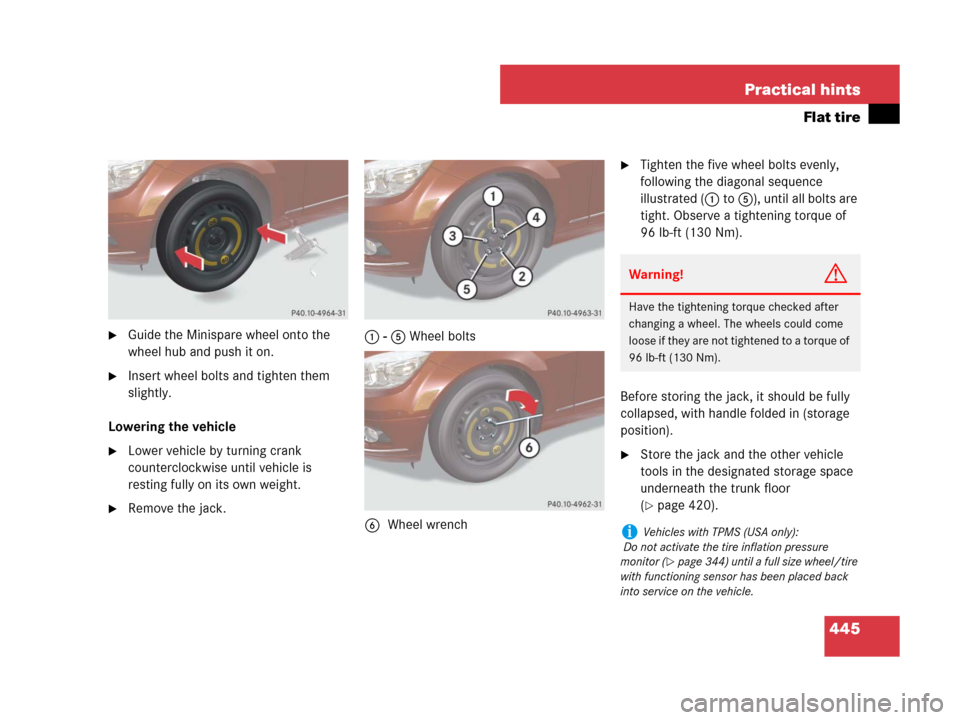
445 Practical hints
Flat tire
�Guide the Minispare wheel onto the
wheel hub and push it on.
�Insert wheel bolts and tighten them
slightly.
Lowering the vehicle
�Lower vehicle by turning crank
counterclockwise until vehicle is
resting fully on its own weight.
�Remove the jack.1 - 5 Wheel bolts
6 Wheel wrench
�Tighten the five wheel bolts evenly,
following the diagonal sequence
illustrated (1 to 5), until all bolts are
tight. Observe a tightening torque of
96 lb-ft (130 Nm).
Before storing the jack, it should be fully
collapsed, with handle folded in (storage
position).
�Store the jack and the other vehicle
tools in the designated storage space
underneath the trunk floor
(
�page 420).
Warning!G
Have the tightening torque checked after
changing a wheel. The wheels could come
loose if they are not tightened to a torque of
96 lb-ft (130 Nm).
iVehicles with TPMS (USA only):
Do not activate the tire inflation pressure
monitor (
�page 344) until a full size wheel/tire
with functioning sensor has been placed back
into service on the vehicle.
Page 449 of 509
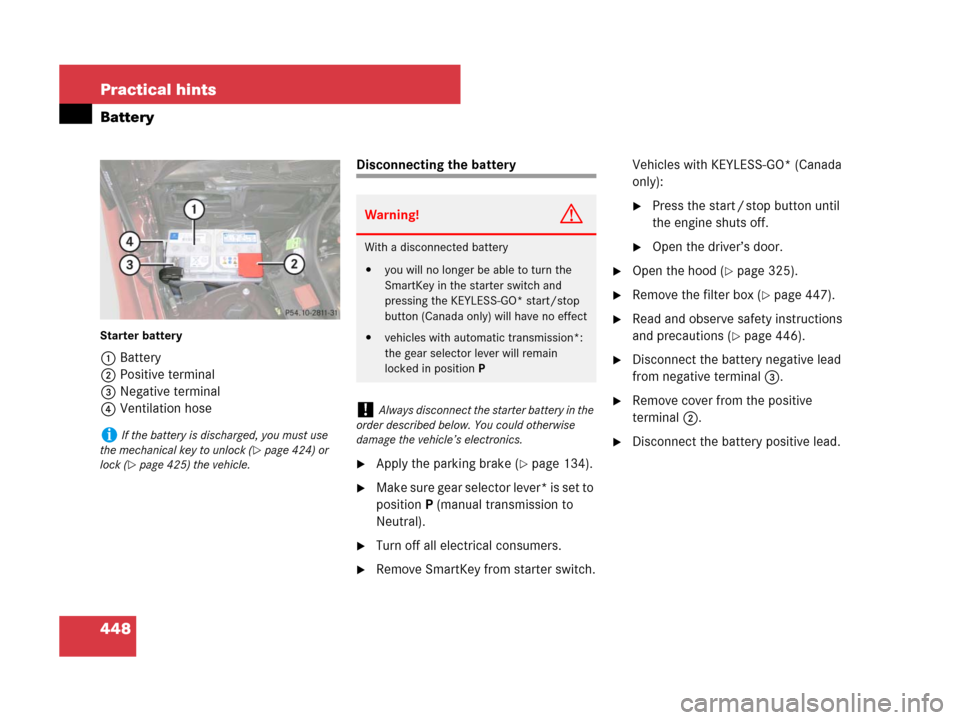
448 Practical hints
Battery
Starter battery
1Battery
2Positive terminal
3Negative terminal
4Ventilation hose
Disconnecting the battery
�Apply the parking brake (�page 134).
�Make sure gear selector lever* is set to
positionP (manual transmission to
Neutral).
�Turn off all electrical consumers.
�Remove SmartKey from starter switch.Vehicles with KEYLESS-GO* (Canada
only):
�Press the start / stop button until
the engine shuts off.
�Open the driver’s door.
�Open the hood (�page 325).
�Remove the filter box (�page 447).
�Read and observe safety instructions
and precautions (
�page 446).
�Disconnect the battery negative lead
from negative terminal3.
�Remove cover from the positive
terminal2.
�Disconnect the battery positive lead.iIf the battery is discharged, you must use
the mechanical key to unlock (
�page 424) or
lock (
�page 425) the vehicle.
Warning!G
With a disconnected battery
�you will no longer be able to turn the
SmartKey in the starter switch and
pressing the KEYLESS-GO* start/stop
button (Canada only) will have no effect
�vehicles with automatic transmission*:
the gear selector lever will remain
locked in positionP
!Always disconnect the starter battery in the
order described below. You could otherwise
damage the vehicle’s electronics.
Page 451 of 509
450 Practical hints
Battery
Reconnecting the battery
�Turn off all electrical consumers.
�Remove SmartKey from starter switch.
Vehicles with KEYLESS-GO* (Canada
only):
�Open the driver’s door.
�Connect the battery positive lead and
fasten its cover (
�page 448).
�Connect the battery negative lead
(
�page 448).
�Make sure that the ventilation hose4
is attached to the battery.
�Reinstall filter box (�page 447).
!Always connect the starter battery in the or-
der described below. Otherwise, the vehicle’s
electronics could be damaged.
!Never invert the terminal connections.
!Make sure the battery has a plug where the
ventilation hose
4 is attached to it.
iThe following procedures must be carried
out following any interruption of battery power
(e.g. due to reconnecting):
�Reset the automatic exterior mirror fold in
function (
�page 99).
�Set the clock (�page 170).
Vehicles with COMAND*: see COMAND op-
erator’s manual.